Publications
- All
- Tranportation Research Part-B
- Tranportation Research Part-C
- Tranportation Science
- Tranportation Research Part-F
- PloS One
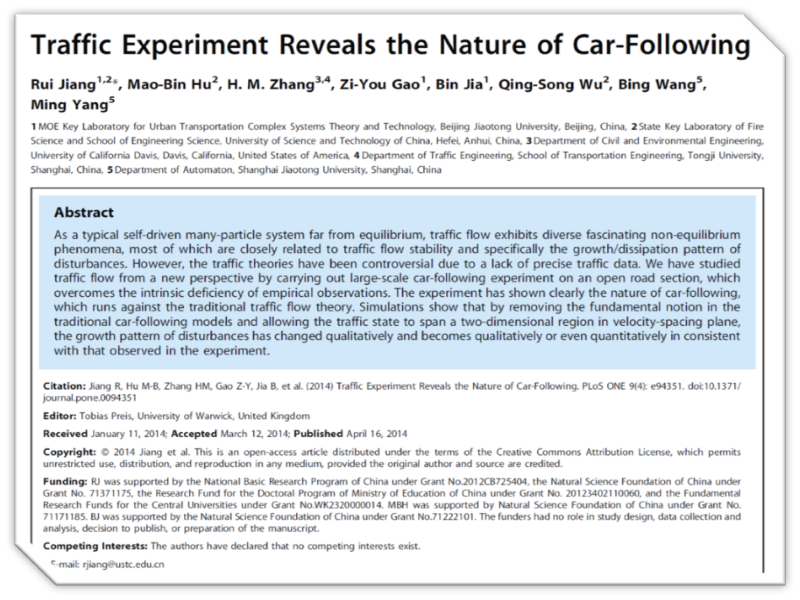
Jiang, R., Hu, M. B., Zhang, H. M., Gao, Z. Y., Jia, B., Wu, Q. S., Wang, B., Yang, M. (2014). Traffic experiment reveals the nature of car-following. PloS one, 9(4), e94351.
Traffic experiment reveals the nature of car-following
As a typical self-driven many-particle system far from equilibrium, traffic flow exhibits diverse fascinating non-equilibrium phenomena, most of which are closely related to traffic flow stability and specifically the growth/dissipation pattern of disturbances. However, the traffic theories have been controversial due to a lack of precise traffic data. We have studied traffic flow from a new perspective by carrying out large-scale car-following experiment on an open road section, which overcomes the intrinsic deficiency of empirical observations. The experiment has shown clearly the nature of car-following, which runs against the traditional traffic flow theory. Simulations show that by removing the fundamental notion in the traditional car-following models and allowing the traffic state to span a two-dimensional region in velocity-spacing plane, the growth pattern of disturbances has changed qualitatively and becomes qualitatively or even quantitatively in consistent with that observed in the experiment.
Citation: Jiang, R., Hu, M. B., Zhang, H. M., Gao, Z. Y., Jia, B., Wu, Q. S., Wang, B., Yang, M. (2014). Traffic experiment reveals the nature of car-following. PloS one, 9(4), e94351.
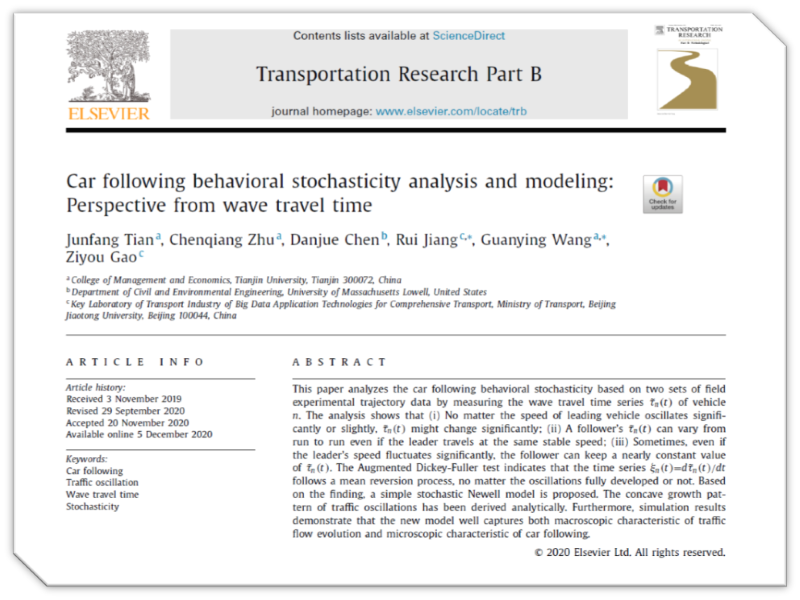
Tian, J., Zhu, C., Chen, D., Jiang, R., Wang, G., and Gao, Z. Car following behavioral stochasticity analysis and modeling: Perspective from wave travel time. Transportation Research Part B: Methodological, 143:160–176 (2021).
Car following behavioral stochasticity analysis and modeling: Perspective from wave travel time
This paper analyzes the car following behavioral stochasticity based on two sets of field experimental trajectory data by measuring the wave travel time series τ ̃_n (t) of vehicle n. The analysis shows that (i) No matter the speed of leading vehicle oscillates significantly or slightly, τ ̃_n (t) might change significantly; (ii) A follower's τ ̃_n (t) can vary from run to run even if the leader travels at the same stable speed; (iii) Sometimes, even if the leader's speed fluctuates significantly, the follower can keep a nearly constant value of τ ̃_n (t). The Augmented Dickey-Fuller test indicates that the time series ξ_n (t)=dτ ̃_n (t)/dt follows a mean reversion process, no matter the oscillations fully developed or not. Based on the finding, a simple stochastic Newell model is proposed. The concave growth pattern of traffic oscillations has been derived analytically. Furthermore, simulation results demonstrate that the new model well captures both macroscopic characteristic of traffic flow evolution and microscopic characteristic of car following.
Citation: Tian, J., Zhu, C., Chen, D., Jiang, R., Wang, G., and Gao, Z. Car following behavioral stochasticity analysis and modeling: Perspective from wave travel time. Transportation Research Part B: Methodological, 143:160–176 (2021).
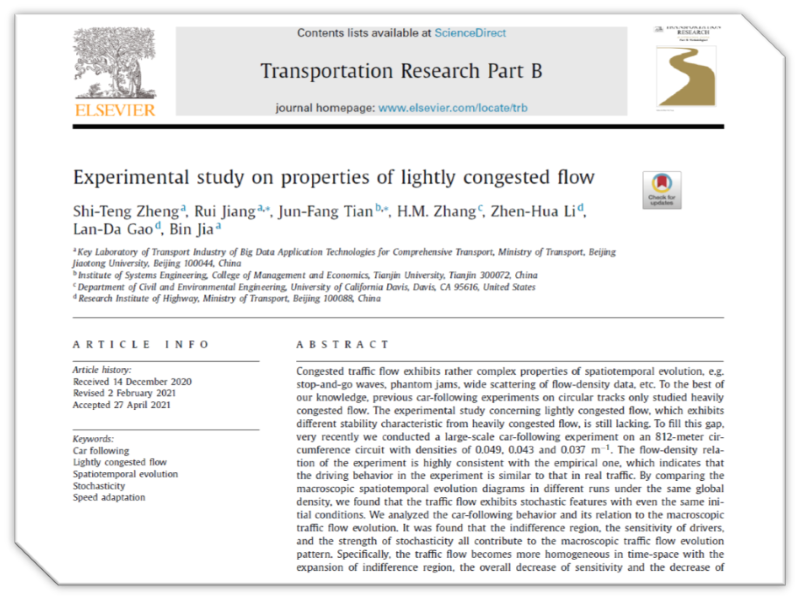
Zheng, S.-T., Jiang, R., Tian, J.-F., Zhang, H., Li, Z.-H., Gao, L.-D., and Jia, B. Experimental study on properties of lightly congested flow. Transportation Research Part B: Methodological, 149:1–19 (2021).
Experimental study on properties of lightly congested flow
Congested traffic flow exhibits rather complex properties of spatiotemporal evolution, e.g. stop-and-go waves, phantom jams, wide scattering of flow-density data, etc. To the best of our knowledge, previous car-following experiments on circular tracks only studied heavily congested flow. The experimental study concerning lightly congested flow, which exhibits different stability characteristic from heavily congested flow, is still lacking. To fill this gap, very recently we conducted a large-scale car-following experiment on an 812-meter circumference circuit with densities of 0.049, 0.043 and 0.037 m−1. The flow-density relation of the experiment is highly consistent with the empirical one, which indicates that the driving behavior in the experiment is similar to that in real traffic. By comparing the macroscopic spatiotemporal evolution diagrams in different runs under the same global density, we found that the traffic flow exhibits stochastic features with even the same initial conditions. We analyzed the car-following behavior and its relation to the macroscopic traffic flow evolution. It was found that the indifference region, the sensitivity of drivers, and the strength of stochasticity all contribute to the macroscopic traffic flow evolution pattern. Specifically, the traffic flow becomes more homogeneous in time-space with the expansion of indifference region, the overall decrease of sensitivity and the decrease of stochasticity strength. The roles of stochasticity and speed adaptation were further investigated. It was found that stronger traffic oscillations correspond to stronger stochasticity and speed adaptation. The analysis for competition between the two effects indicated that the ratio between speed adaptation effect and stochastic effect grows with the increase of the oscillation amplitude. The stochastic effect plays a dominant role in car following when the oscillation amplitude is small; its influence wanes and the speed adaptation effect grows to outweigh the influence of the stochastic effect as oscillation amplitude grows. These findings are expected to improve our understanding of the underlying mechanism that produces the spatiotemporal evolution patterns of lightly congested flow and the data collected in this study can be used to test traffic models and theories.
Citation: Zheng, S.-T., Jiang, R., Tian, J.-F., Zhang, H., Li, Z.-H., Gao, L.-D., and Jia, B.Experimental study on properties of lightly congested flow. Transportation Research Part B: Methodological, 149:1–19 (2021).
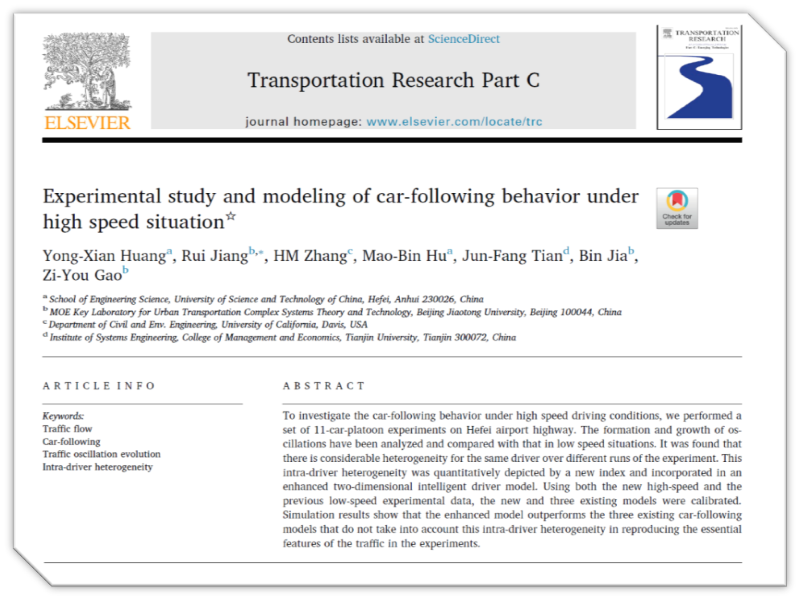
Huang, Y.-X., Jiang, R., Zhang, H., Hu, M.-B., Tian, J.-F., Jia, B., and Gao, Z.-Y. Experimental study and modeling of car-following behavior under high speed situation. Transportation Research Part C: Emerging Technologies, 97:194–215 (2018).
Experimental study and modeling of car-following behavior under high speed situation
To investigate the car-following behavior under high speed driving conditions, we performed a set of 11-car-platoon experiments on Hefei airport highway. The formation and growth of oscillations have been analyzed and compared with that in low speed situations. It was found that there is considerable heterogeneity for the same driver over different runs of the experiment. This intra-driver heterogeneity was quantitatively depicted by a new index and incorporated in an enhanced two-dimensional intelligent driver model. Using both the new high-speed and the previous low-speed experimental data, the new and three existing models were calibrated. Simulation results show that the enhanced model outperforms the three existing car-following models that do not take into account this intra-driver heterogeneity in reproducing the essential features of the traffic in the experiments.
Citation: Huang, Y.-X., Jiang, R., Zhang, H., Hu, M.-B., Tian, J.-F., Jia, B., and Gao, Z.-Y. Experimental study and modeling of car-following behavior under high speed situation. Transportation Research Part C: Emerging Technologies, 97:194–215 (2018).
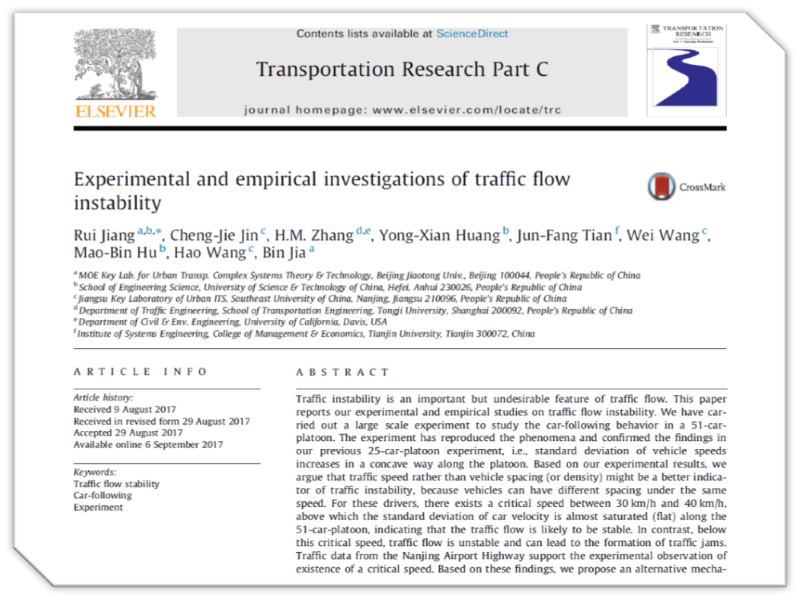
Jiang, R., Jin, C.-J., Zhang, H., Huang, Y.-X., Tian, J.-F., Wang, W., Hu, M.-B., Wang, H., and Jia, B. Experimental and empirical investigations of traffic flow instability. Transportation Research Part C: Emerging Technologies, 94:83–98 (2018).
Experimental and empirical investigations of traffic flow instability
Traffic instability is an important but undesirable feature of traffic flow. This paper reports our experimental and empirical studies on traffic flow instability. We have carried out a large scale experiment to study the car-following behavior in a 51-car-platoon. The experiment has reproduced the phenomena and confirmed the findings in our previous 25-car-platoon experiment, i.e., standard deviation of vehicle speeds increases in a concave way along the platoon. Based on our experimental results, we argue that traffic speed rather than vehicle spacing (or density) might be a better indicator of traffic instability, because vehicles can have different spacing under the same speed. For these drivers, there exists a critical speed between 30 km/h and 40 km/h, above which the standard deviation of car velocity is almost saturated (flat) along the 51-car-platoon, indicating that the traffic flow is likely to be stable. In contrast, below this critical speed, traffic flow is unstable and can lead to the formation of traffic jams. Traffic data from the Nanjing Airport Highway support the experimental observation of existence of a critical speed. Based on these findings, we propose an alternative mechanism of traffic instability: the competition between stochastic factors and the so-called speed adaptation effect, which can better explain the concave growth of speed standard deviation in traffic flow.
Citation: Jiang, R., Jin, C.-J., Zhang, H., Huang, Y.-X., Tian, J.-F., Wang, W., Hu, M.-B., Wang, H., and Jia, B. Experimental and empirical investigations of traffic flow instability. Transportation Research Part C: Emerging Technologies, 94:83–98 (2018).
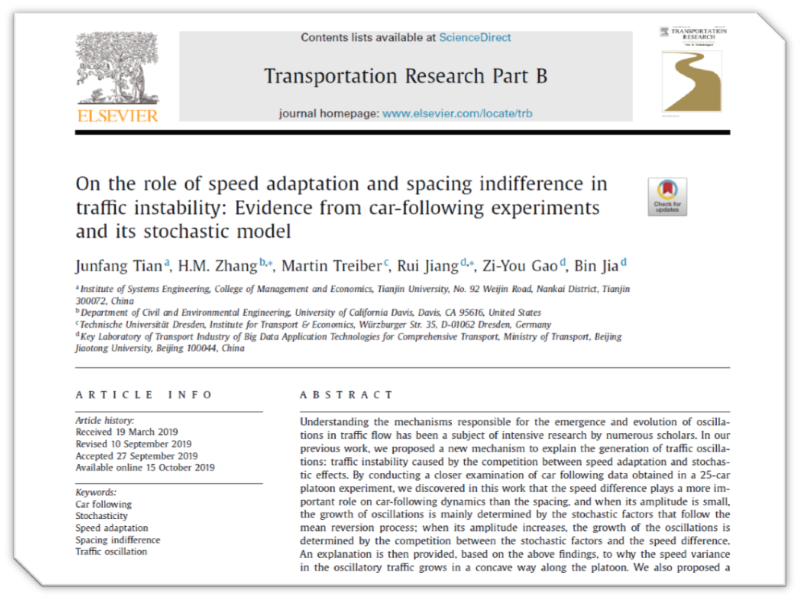
Tian, J., Zhang, H. M., Treiber, M., Jiang, R., Gao, Z. Y., & Jia, B. (2019). On the role of speed adaptation and spacing indifference in traffic instability: Evidence from car-following experiments and its stochastic model. Transportation research part B: methodological, 129, 334-350.
On the role of speed adaptation and spacing indifference in traffic instability: Evidence from car-following experiments and its stochastic model
Understanding the mechanisms responsible for the emergence and evolution of oscillations in traffic flow has been a subject of intensive research by numerous scholars. In our previous work, we proposed a new mechanism to explain the generation of traffic oscillations: traffic instability caused by the competition between speed adaptation and stochastic effects. By conducting a closer examination of car following data obtained in a 25-car platoon experiment, we discovered in this work that the speed difference plays a more important role on car-following dynamics than the spacing, and when its amplitude is small, the growth of oscillations is mainly determined by the stochastic factors that follow the mean reversion process; when its amplitude increases, the growth of the oscillations is determined by the competition between the stochastic factors and the speed difference. An explanation is then provided, based on the above findings, to why the speed variance in the oscillatory traffic grows in a concave way along the platoon. We also proposed a mode-switching stochastic car-following model that incorporates the speed adaptation and spacing indifference behavior of drivers, which captures the observed characteristics of oscillation and discharge rate. Finally, our sensitivity analysis shows that the influence on oscillation growth and discharge rate is small by the reaction delay but large by the indifference region boundary.
Citation: Tian, J., Zhang, H. M., Treiber, M., Jiang, R., Gao, Z. Y., & Jia, B. (2019). On the role of speed adaptation and spacing indifference in traffic instability: Evidence from car-following experiments and its stochastic model. Transportation research part B: methodological, 129, 334-350.
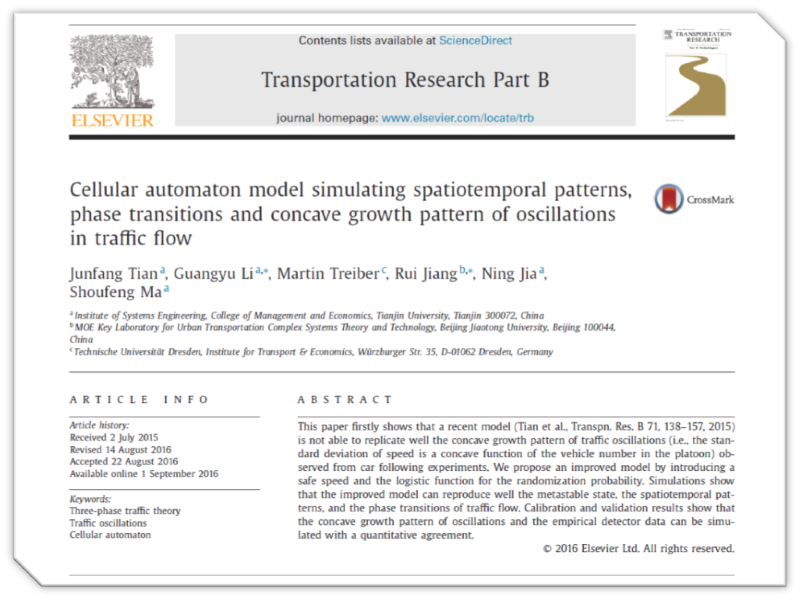
Tian, J. , Rui, J. , Li, G. , Treiber, M. , & Ma, S. . (2016). Cellular automaton model simulating spatiotemporal patterns, phase transitions and evolution concavity in traffic flow. Transportation Research Part B Methodological, 93, 560-575.
Cellular automaton model simulating spatiotemporal patterns, phase transitions and evolution concavity in traffic flow
This paper firstly show that a recent model (Tian et al., Transpn. Res. B 71, 138-157, 2015) is not able to well replicate the evolution concavity in traffic flow, i.e. the standard deviation of vehicles increases in a concave/linear way along the platoon. Then we propose an improved model by introducing the safe speed, the logistic function of the randomization probability, and small randomization deceleration for low-speed vehicles into the model. Simulations show that the improved model can well reproduce the metastable states, the spatiotemporal patterns, the phase transition behaviors of traffic flow, and the evolution concavity of traffic oscillations. Validating results show that the empirical time series of traffic speed obtained from Floating Car Data can be well simulated as well.
Citation: Tian, J. , Rui, J. , Li, G. , Treiber, M. , & Ma, S. . (2016). Cellular automaton model simulating spatiotemporal patterns, phase transitions and evolution concavity in traffic flow. Transportation Research Part B Methodological, 93, 560-575.
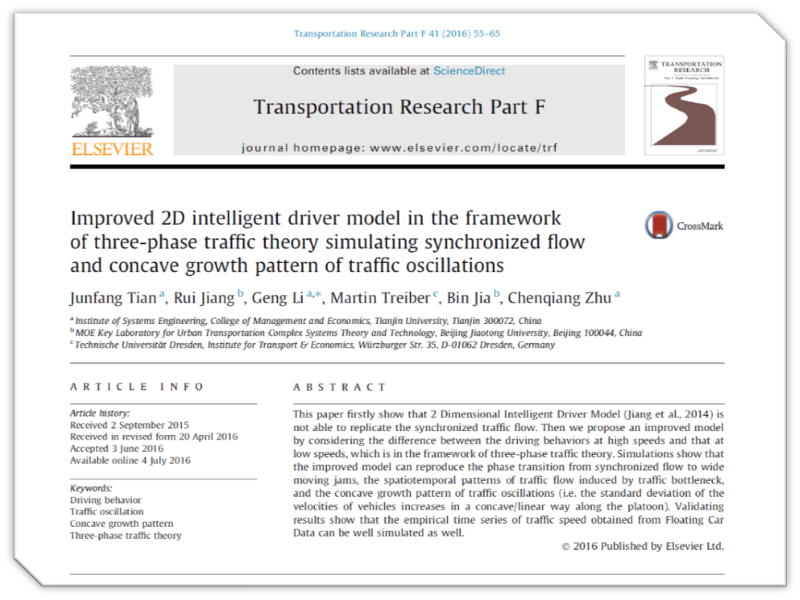
Tian, J. , Jiang, R. , Li, G. , Treiber, M. , Jia, B. , & Zhu, C. . (2016). Improved 2d intelligent driver model in the framework of three-phase traffic theory simulating synchronized flow and concave growth pattern of traffic oscillations. Transportation Research Part F Traffic Psychology & Behaviour, 41(pt.A), 55-65.
Improved 2d intelligent driver model in the framework of three-phase traffic theory simulating synchronized flow and concave growth pattern of traffic oscillations
This paper firstly show that 2 Dimensional Intelligent Driver Model (Jiang et al., 2014) is not able to replicate the synchronized traffic flow. Then we propose an improved model by considering the difference between the driving behaviors at high speeds and that at low speeds, which is in the framework of three-phase traffic theory. Simulations show that the improved model can reproduce the phase transition from synchronized flow to wide moving jams, the spatiotemporal patterns of traffic flow induced by traffic bottleneck, and the concave growth pattern of traffic oscillations (i.e. the standard deviation of the velocities of vehicles increases in a concave/linear way along the platoon). Validating results show that the empirical time series of traffic speed obtained from Floating Car Data can be well simulated as well.
Citation: Tian, J. , Jiang, R. , Li, G. , Treiber, M. , Jia, B. , & Zhu, C. . (2016). Improved 2d intelligent driver model in the framework of three-phase traffic theory simulating synchronized flow and concave growth pattern of traffic oscillations. Transportation Research Part F Traffic Psychology & Behaviour, 41(pt.A), 55-65.
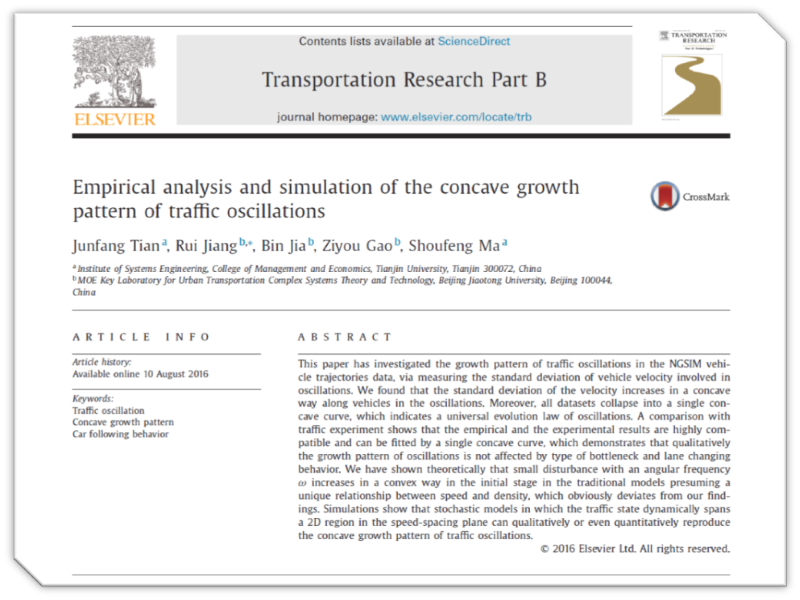
Junfang Tian, Rui Jiang, Bin Jia, Ziyou Gao, Shoufeng Ma (2015). Empirical analysis and simulation of the evolution concavity of traffic oscillations. Transportation Research Part B: Methodological, 93, 338–354.
Empirical analysis and simulation of the evolution concavity of traffic oscillations
This paper has investigated the growth pattern of traffic oscillations in the NGSIM vehicle trajectories data, via measuring the standard deviation of vehicle velocity involved in oscillations. We found that the standard deviation of the velocity increases in a concave way along vehicles in the oscillations. Moreover, all datasets collapse into a single concave curve, which indicates a universal evolution law of oscillations. A comparison with traffic experiment shows that the empirical and the experimental results are highly compatible and can be fitted by a single concave curve, which demonstrates that qualitatively the growth pattern of oscillations is not affected by type of bottleneck and lane changing behavior. We have shown theoretically that small disturbances increase in a convex way in the initial stage in the traditional models presuming a unique relationship between speed and density, which obviously deviates from our findings. Simulations show that stochastic models in which the traffic state dynamically spans a 2D region in the speed-spacing plane can qualitatively or even quantitatively reproduce the concave growth pattern of traffic oscillations.
Citation: Junfang Tian, Rui Jiang, Bin Jia, Ziyou Gao, Shoufeng Ma (2015). Empirical analysis and simulation of the evolution concavity of traffic oscillations. Transportation Research Part B: Methodological, 93, 338–354.
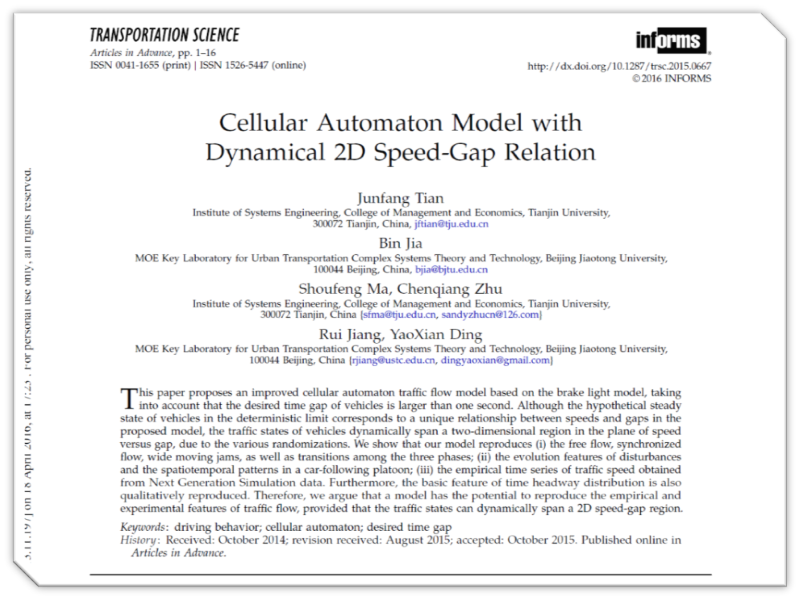
Junfang Tian, Bin Jia, Shoufeng Ma, Chenqiang Zhu, Rui Jiang, YaoXian Ding (2017) Cellular Automaton Model with Dynamical 2D Speed-Gap Relation. Transportation Science, 51(3):807-822.
Cellular Automaton Model with Dynamical 2D Speed-Gap Relation
This paper proposes an improved cellular automaton traffic flow model based on the brake light model, taking into account that the desired time gap of vehicles is larger than one second. Although the hypothetical steady state of vehicles in the deterministic limit corresponds to a unique relationship between speeds and gaps in the proposed model, the traffic states of vehicles dynamically span a two-dimensional region in the plane of speed versus gap, due to the various randomizations. We show that our model reproduces (i) the free flow, synchronized flow, wide moving jams, as well as transitions among the three phases; (ii) the evolution features of disturbances and the spatiotemporal patterns in a car-following platoon; (iii) the empirical time series of traffic speed obtained from Next Generation Simulation data. Furthermore, the basic feature of time headway distribution is also qualitatively reproduced. Therefore, we argue that a model has the potential to reproduce the empirical and experimental features of traffic flow, provided that the traffic states can dynamically span a 2D speed-gap region.
Citation: Junfang Tian, Bin Jia, Shoufeng Ma, Chenqiang Zhu, Rui Jiang, YaoXian Ding (2017) Cellular Automaton Model with Dynamical 2D Speed-Gap Relation. Transportation Science, 51(3):807-822.
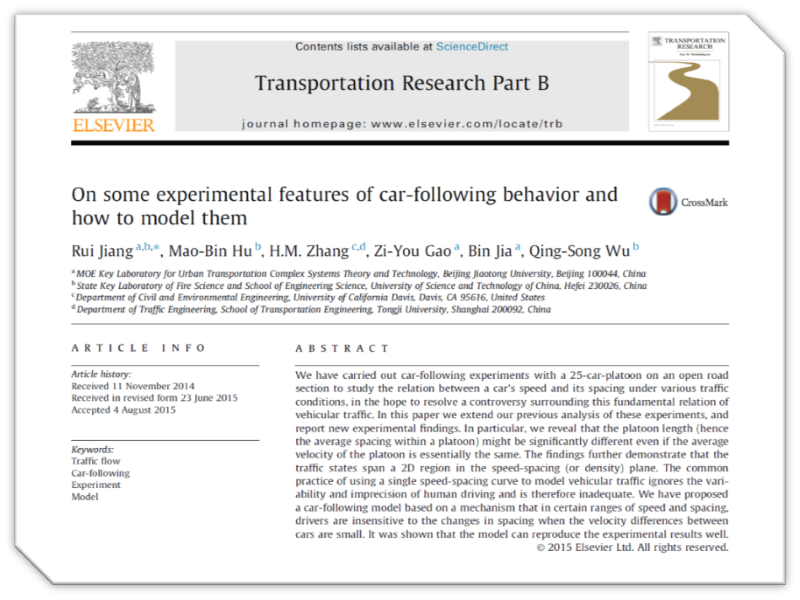
Rui Jiang , MaoBin Hu , H.M.Zhang , ZiYou Gao , Bin Jia , Qingsong Wu (2015) On some experimental features of car-following behavior and how to model them. Transportation Research Part B: Methodological, 80, 338-354.
On some experimental features of car-following behavior and how to model them
We have carried out car-following experiments with a 25-car-platoon on an open road section to study the relation between a car’s speed and its spacing under various traffic conditions, in the hope to resolve a controversy surrounding this fundamental relation of vehicular traffic. In this paper we extend our previous analysis of these experiments, and report new experimental findings. In particular, we reveal that the platoon length (hence the average spacing within a platoon) might be significantly different even if the average velocity of the platoon is essentially the same. The findings further demonstrate that the traffic states span a 2D region in the speed-spacing (or density) plane. The common practice of using a single speed-spacing curve to model vehicular traffic ignores the variability and imprecision of human driving and is therefore inadequate. We have proposed a car-following model based on a mechanism that in certain ranges of speed and spacing, drivers are insensitive to the changes in spacing when the velocity differences between cars are small. It was shown that the model can reproduce the experimental results well.
Citation: Rui Jiang , MaoBin Hu , H.M.Zhang , ZiYou Gao , Bin Jia , Qingsong Wu (2015) On some experimental features of car-following behavior and how to model them. Transportation Research Part B: Methodological, 80, 338-354.

